TENETS OF TERRORISM-News anchors scratch their heads. How could they have done this? How could a happily married young couple, with a good income, a six-month-old baby, and no apparent history of “radicalization,” execute this military-style massacre of 14 people in San Bernardino? Gosh, how to understand these people?
Actually, I think it’s not so difficult to grasp. One just has to examine the question seriously and not begin with the assumption that such massacres are incomprehensible—the products of minds so alien to our own that comprehending itself isn’t possible.
It seems to me that the basic components of ISIL-type ideology are quite obvious and can be distilled as follows.
1.There is a God, a Creator of the Cosmos, who has communicated His will to humankind through written texts transcribed by inspired men that set down His law.
This is a concept common to monotheistic religions, including Judaism and Christianity as well as Islam. It does not automatically lead to terrorism, of course, even when it’s unthinkingly embraced by people incapable of rational doubt or nuanced thinking. (Such people are well represented among this country’s Christians, and in the documented world history of Judaism and Christianity we find many instances of wholesale slaughter of communities by believers supposedly directed by the Almighty Himself.)
But if God-belief doesn’t automatically lead to terrorism, it’s obviously one premise of Islamist jihadi terrorism. So this is the starting point of any analysis of that phenomenon.
2. Islam, based upon the Holy Qur’an, transmitted to humankind through the Prophet Muhammad and embraced by the global Ummah (Muslim community), is at war with the West.
The many conflicts, pitting western parties against Muslim ones, constitute this worldwide war. The western-backed Israelis occupy Arab land and abuse and butcher Palestinians. (In the Gaza War of 2014 the Israelis killed over 2000 Palestinians, around two-thirds of them civilians.) Western countries with the U.S. at their head support brutal dictatorships in the Muslim world, including monarchies and republics, all of which oppress the Muslim citizenry. The U.S. and allies routinely invade Muslim countries, killing hundreds of thousands and defiling these lands with their infidel presence. Meanwhile western popular culture invades Muslim nations, corrupting the youth with its immorality.
This is not (as the jihadis see it) a conflict recently hatched. It harks back to the Crusades, and the bloody Christian occupation of Jerusalem in the twelfth and thirteenth centuries; the struggle for Spain, culminating in the expulsion of Muslims in 1492; the European colonization of North Africa beginning in the early nineteenth century, and brutal suppression of Muslim resistance; the division of former Ottoman lands in the Arab Middle East by the French and English colonialists after World War I, and the brutal suppression of resistance, especially in Iraq; and the Palestinian Nakba of 1948. Is it not obvious—the anti-west jihadi thinks—that we are at war, and have been for hundreds of years?
3. It is incumbent on all Muslims to defend the Ummah when it is under attack.
The Qur’an says: “Fight in God’s cause against those who fight you… Kill them whenever you encounter them…” (2:190-91). If you understand that the Muslim world is in fact at war, you must as a pious believer take your stand.
4. Terrorism is justified, indeed required, by God (Allah).
(A reminder: “Allah” is merely the Arab word for God, related to the Hebrew “Elohim.”) The passage cited above also cautions the Muslim: “…but do not overstep the limits. God does not love those who overstep the limits.” And the Qur’an recognizes Jews and Christians as fellow believers in God, and specifies that there should be “no compulsion in religion” (2:256 ). But it also (like most scriptures) contains contradictions and passages that appear to justify all kinds of violent response to “those who wage war against Allah and His messenger and strive to make mischief in the land” (5:33).
This verse specifies that these forces at war against Allah “should be murdered or crucified or their hands and their feet should be cut off on opposite sides or they should be imprisoned…” Verse 8:57 calls upon the Muslim warrior to “deal with [the enemy] so as to strike fear in those who are behind them, that happily they remember.”
Because the enemy in this case has overwhelming military power, the jihadis must wage asymmetric warfare, using the “weapons of the weak.” Bin Laden and other radical Islamists find in the Qur’an moral justification for attacks on civilians to strike such fear. Al-Qaeda leader Ayman al-Zawahiri argued in a book published in 1995, entitled “The Rule for Suicide-Martyr Operations,” that the killing of non-combatants in the defense of Islam is not immoral. Osama bin Laden told al-Jazeera in October 2001 that, while it was true that “the Prophet [in hadith] forbade the killing of women and children…this forbidding of killing children and innocents is not set in stone…if the disbelievers were to kill our children and women, then we should not feel ashamed to do the same to them, mainly to deter them from trying to kill our children and women again.”
This validation of random killing is a major break from traditional modern Muslim teaching, and the essence of what the U.S. media and law enforcement have taken to calling “radicalization.”
Much like their counterparts in other religious traditions, Muslim clerics overwhelmingly reject any justification for attacks on civilians. U.S. Muslims in particular resist the rationalization of such attacks. (A 2011 Gallop poll showed that while in the U.S. 58% of Christians, 52% of Jews, and 43% of non-religious thought it “sometimes justified” for “the military to target and kill civilians” only 21% of Muslims agreed.) But this is the doctrinal point of departure for what is usually called “Islamic terrorism.”
(One must note in passing that this comfort level with mass slaughter of innocents found in some Muslim texts is hardly unique to Islam. It is similarly revealed in Old Testament passages that long predate the inception of Islam, and indeed helped shape Muslim thinking. For example, the prophet Samuel, speaking on behalf of God (Yahweh) in the Bible advocates the genocide of a fellow Semitic people, the Amalekites. He tells King Saul to “attack the Amalekites…Do not spare them; put to death women, children and infants, cattle and sheep, camels and donkeys” [1 Samuel 15:3].
Such words resonate in the brains of Jewish terrorists like Baruch Goldstein, an a U.S.-born Israeli physician who killed 29 Muslims including seven children, and wounded 125 in Hebron in 1994; and also in the brains of Christian terrorists like self-described “100% Christian” Anders Behring Breivik, who killed 77 innocents including 55 teenagers in Norway in 2011 to protest multiculturalism and tolerance of Islam.)
5. Just as there is unquestionably a Creator God, who communicates to us through the Holy Qur’an and the hadith (sayings of Mohammad), so there is surely a life of the soul after death, and the rebirth of martyrs in Paradise.
So there is both broad license for the believer to break with conventional morality—liberated from its norms, to do the unthinkable, shocking the world through the massive bloody infliction of indiscriminate suffering—and mental assurance that (following the act of spectacular terror) the holy warrior-terrorists if killed in the mission will be reborn in “Gardens of Bliss.” There they will “sit on couches of well-woven cloth,” offered viands and drinks by “everlasting youths who will go round among them” while “beautiful [female] companions like hidden pearls” attend them too (56:12-24).
6. By sowing terror among the enemies of Allah, killing their children, shocking the enemy by such measures as mentioned in Qur’an 5:33, the jihadis hasten the day of a general showdown between Islam and the west and the re-establishment of the Caliphate of the seventh century.
(ISIL draws upon a particular tradition of apocalyptic prophecy and preaches that jihadi acts of violence from the battlefields of Iraq to Yemen to Libya and beyond as well as lone-wolf terrorist actions in western nations all contribute to the realization of this glorious end.) Thus the sacrifice of one’s life has profound, enduring meaning for all generations to come. One plays one’s heroic role in that which was foretold, shooting down innocents knowing they are not really innocent in God’s eyes and that one’s own actions enjoy divine approval.
ISIL propaganda refers to the “grey zone,” meaning the global Muslim population standing between the enemy (the “crusader nations”) and the Islamic State jihadis—Muslims who must ultimate join the cause of the caliphate or stand with those who increasingly monitor, mistrust and vilify them.
Millions of Muslims inhabit this zone, potentially joining it, like the San Berrnardino couple.
* * *
This ideology is ultimately a product of—often rational—indignation at the state of the world, paired with the destructive potential of religious delusion. There’s no question but that it’s a hideous worldview and should sicken any clear-minded person. But in its validation of random slaughter, it not only draws upon a rich tradition in monotheistic religion but the history of modern imperialism.
Didn’t U.S. General Curtis LeMay boast in 1945 that the U.S. would “bomb Japan back to the Stone Age” for the grave sin of attacking Pearl Harbor in 1941—bombed after the U.S. had shut off Japan’s oil supply and frozen its bank assets—and killing 2400 troops?
Didn’t this Ohio Methodist boast that the U.S. would “scorch and boil and bake to death…every man, woman and child” in Tokyo, a city that ought to be “burned down—wiped right off the map—to shorten the war”? And didn’t U.S. firebombing on the night of March 9, 1945 alone indeed incinerate 100,000 Japanese men, women and children? And didn’t this atrocity via “conventional” war lead to the indiscriminate annihilation of the civilian populations of Hiroshima and Nagasaki five months later?
Didn’t U.S. forces in the Philippines (1899-1901), Korea (1950-53), and Vietnam (1964-75) kill millions of women and children? Weren’t the troops accompanied throughout by Christian (and a few Jewish) chaplains who assured them that they had God on their side as they did so?
It’s no more difficult to understand the mindset of Syed Farook and Tashfeen Malik than to understand the mentality of Gen. LeMay. The self-righteous, butt-headed expectation that God is on your side. The antinomian assumption that the normal laws and human feelings don’t apply to you because your mission is special and elite. The confidence that you will never suffer for the suffering you inflict.
The sad fact is that the suicide bomber, or the “suicide by cop” figure, tends to die quickly without suffering. His or her brain dies, sensation ends. The “martyr” does not wake up on the “couch of well-woven cloth” in a blissful garden surrounded by the bounty of Paradise—or in some Inferno somewhere subject to eternal torture—but disappears unpunished, ultimately prey to worms. Death brings no punishment but silence.
No one can say to the departed fanatic: “See, now that you’re dead and nowhere, that your religion-based worldview was a stupid dead-end?” He’s dead. She’s dead. It’s done.
But you can say, to the daily jabbering brain-dead cable-news anchor: This crazy religion-based worldview that puzzles you is not really something so foreign and obscure. It’s something easily comprehensible to Americans on the basis of their own history (which includes the annihilation of native peoples, and the institution of slavery justified by citations of the Bible). It’s understandable in their own current context of ongoing bigotry, resentment and fear.
You don’t need, feigning perplexity, to ask how people can be so vicious. You have a huge backload of unexplored if not meticulously avoided news stories that help explain the jihadis’ rage.
Last Friday Staff Sgt. Dwight L. Smith, Jr. (28), an Army veteran of the Afghan and Iraq wars, was convicted of raping and murdering a 65-year-old woman in Delaware as she walked her dog on December 19, 2011. On leave from Fort Drum, New York, he just wanted to kill somebody that day.
After the killing, Smith wrote to his father, “I’m going to be honest with you dad. I have killed a lot of men and women and children. Some that didn’t even do anything for me to kill them. Also some that begged for mercy. I have a problem. I could kill someone, go to sleep and forget that it ever happened.
“I think I got addicted to killing people,” he explained. “It got normal for me to be that way. I never wanted to be this way. I just took my job way too serious.” It appears he was never brought to trial for any of these self-admitted killings during his deployments. One must wonder how many people he “radicalized” by killing their loved ones.
How could Syed Farook and Tashfeen Malik have cold-bloodedly murdered 14 innocent people at a holiday party Dec. 2? In all probability, it’s because they believed the points listed above, and came to agree with bin Laden that “if the disbelievers were to kill our children and women, then we should not feel ashamed to do the same to them.”
Shouldn’t we note the obvious—that Islamist “radicalization” has soared since the destruction of Iraq in 2003, and has been fed by the disastrous western interventions in Libya and Syria, executed by Sgt. Smiths who take their jobs too seriously and get addicted to killing people? And by drone strikes on Pakistan, Afghanistan and Yemen?
The anti-Assad, pro-U.S. “Syrian Observatory for Human Rights” reported that on May1 of this year U.S. airstrikes killed 52 civilians near Aleppo in Syria. Is this likely to weaken ISIL, the ostensible target, or validate the Islamist charge that the west is at war with Islam and induce more to join the jihad?
Isn’t it obvious that the news anchor really needs to ask, not why some Muslim can “become radicalized” and kill innocent civilians in western cities—as though this were some sort of inscrutable moral riddle—but why U.S. leaders can sleep soundly as their death machines rain down “shock and awe” on Muslim peoples in wars based on lies guaranteed to spawn simmering time bombs like Syed Farook and Tashfeen Malik?
(Gary Leupp is Professor of History at Tufts University, and holds a secondary appointment in the Department of Religion. He is the author of Servants, Shophands and Laborers in in the Cities of Tokugawa Japan. He can be reached at: [email protected]. This piece was first posted on CounterPunch.org.) Prepped for CityWatch by Linda Abrams.
Tags:
CityWatch
Vol 13 Issue 100
Pub: Dec 11, 2015
 DRUG POLITICS--Some folks are just so awful and scurrilous that jail is almost too good for them. As with the bankers and investment companies that destroyed and burned up the life savings of many Americans since the turn of the century (a form of murder, from a financial point of view), pharmaceutical companies have allowed life-saving medicines (many that have been out for decades and are very inexpensive to make) to skyrocket in price ...
DRUG POLITICS--Some folks are just so awful and scurrilous that jail is almost too good for them. As with the bankers and investment companies that destroyed and burned up the life savings of many Americans since the turn of the century (a form of murder, from a financial point of view), pharmaceutical companies have allowed life-saving medicines (many that have been out for decades and are very inexpensive to make) to skyrocket in price ... 
 GELFAND’S WORLD--This being the antepenultimate column of 2015 for me, it seems appropriate to tell the story of a friend of mine who had to deal with corporate America. But this wasn't the usual corporate screw job by a credit card company or by a cell phone company. This was a combination screw job by both a credit card company and a cell phone company together, in one and the same incident.
GELFAND’S WORLD--This being the antepenultimate column of 2015 for me, it seems appropriate to tell the story of a friend of mine who had to deal with corporate America. But this wasn't the usual corporate screw job by a credit card company or by a cell phone company. This was a combination screw job by both a credit card company and a cell phone company together, in one and the same incident. 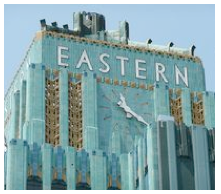 MY TURN--When Councilman Felipe Fuentes (District 7) evicted tenants in the North Valley City Hall, he included a police substation as well as the Sunland Tujunga Neighborhood Council in his purge. Even though a hue and cry was raised by his constituents and this writer; we were told that he had every right to do that. Apparently, who occupies city property is under the purview of the Councilmember in that district.
MY TURN--When Councilman Felipe Fuentes (District 7) evicted tenants in the North Valley City Hall, he included a police substation as well as the Sunland Tujunga Neighborhood Council in his purge. Even though a hue and cry was raised by his constituents and this writer; we were told that he had every right to do that. Apparently, who occupies city property is under the purview of the Councilmember in that district. 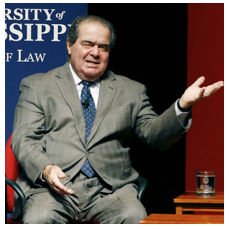 AFFIRMATIVE ACTION REBOOT-Supreme Court Justice Antonin Scalia’s (photo) seeming suggestion this week that students of color would be better off at “a slower-track school where they do well” is not only offensive, it’s wrong.
AFFIRMATIVE ACTION REBOOT-Supreme Court Justice Antonin Scalia’s (photo) seeming suggestion this week that students of color would be better off at “a slower-track school where they do well” is not only offensive, it’s wrong.  CALIFORNIA WATCH--As Governor Jerry Brown touted California’s environmental initiatives and prodded world leaders in Paris to embrace tougher environmental policies during the United Nations summit on climate change, it was instructive to look back at how one of Brown’s top environmental priorities suffered a major defeat in the California Legislature this year.
CALIFORNIA WATCH--As Governor Jerry Brown touted California’s environmental initiatives and prodded world leaders in Paris to embrace tougher environmental policies during the United Nations summit on climate change, it was instructive to look back at how one of Brown’s top environmental priorities suffered a major defeat in the California Legislature this year.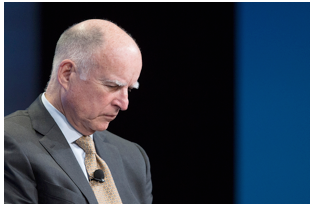 In speaking against the petroleum reduction measure, the bill’s opponents warned that it could result in gas rationing and prohibitions on sport utility vehicles. Opponents, including some Democratic lawmakers, also claimed that cutting petroleum use would be disproportionally harmful to residents of the Central Valley, whose long commutes and dearth of public transportation make dependence on automobiles – and fuel – a certainty.
In speaking against the petroleum reduction measure, the bill’s opponents warned that it could result in gas rationing and prohibitions on sport utility vehicles. Opponents, including some Democratic lawmakers, also claimed that cutting petroleum use would be disproportionally harmful to residents of the Central Valley, whose long commutes and dearth of public transportation make dependence on automobiles – and fuel – a certainty.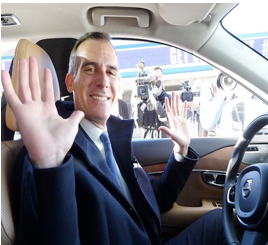 NO SUBSTITUTE FOR WALKABLE STREETS--At the center of UCLA’s campus, there’s a banner advertising some of the university’s newest groundbreaking research. It features the outline of a small vehicle and reads, “The 405 is a joyride … in a driverless car.”
NO SUBSTITUTE FOR WALKABLE STREETS--At the center of UCLA’s campus, there’s a banner advertising some of the university’s newest groundbreaking research. It features the outline of a small vehicle and reads, “The 405 is a joyride … in a driverless car.”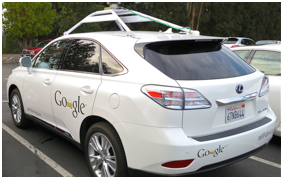 All this portends a brighter future for LA and similar cities. But even today, the truth is that my car-free lifestyle is very doable — sometimes even convenient. LA has a robust bus system that I use to commute to UCLA, and so far I’ve found it to be reliable (LA’s bus and train networks combine for about 1.5 million weekday boardings, third in the nation after New York and Chicago). My home in the Palms neighborhood is a 15-minute walk from a light rail stop that takes me to Downtown LA, which has recently come into its own as a cultural and culinary hotspot. Almost everything I need is within biking distance of my apartment, and when I have to, I can rely on the generosity of friends with cars.
All this portends a brighter future for LA and similar cities. But even today, the truth is that my car-free lifestyle is very doable — sometimes even convenient. LA has a robust bus system that I use to commute to UCLA, and so far I’ve found it to be reliable (LA’s bus and train networks combine for about 1.5 million weekday boardings, third in the nation after New York and Chicago). My home in the Palms neighborhood is a 15-minute walk from a light rail stop that takes me to Downtown LA, which has recently come into its own as a cultural and culinary hotspot. Almost everything I need is within biking distance of my apartment, and when I have to, I can rely on the generosity of friends with cars.
 And that's what leads to the next point. If it's not the local police, who does make the decision to keep all these jails closed? It's not going to be a deep revelation that this kind of decision comes out of the city's budget process. Could the city find the dollars to open the Harbor Area Jail if it were considered a weighty enough priority? Obviously it could. But that decision would come at the cost of other priorities.
And that's what leads to the next point. If it's not the local police, who does make the decision to keep all these jails closed? It's not going to be a deep revelation that this kind of decision comes out of the city's budget process. Could the city find the dollars to open the Harbor Area Jail if it were considered a weighty enough priority? Obviously it could. But that decision would come at the cost of other priorities. 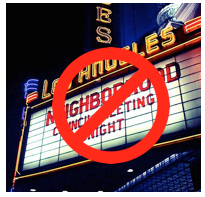 DOWNTOWN- This week, the Downtown Los Angeles Neighborhood Council (DLANC) had to cancel it’s monthly Board meeting after being informed of their Brown Act violations. This comes after last week’s abrupt cancellation of the DLANC Executive Committee meeting.
DOWNTOWN- This week, the Downtown Los Angeles Neighborhood Council (DLANC) had to cancel it’s monthly Board meeting after being informed of their Brown Act violations. This comes after last week’s abrupt cancellation of the DLANC Executive Committee meeting. 

 SPORTS POLITICS--On Monday, former University of Southern California head football coach Steve Sarkisian
SPORTS POLITICS--On Monday, former University of Southern California head football coach Steve Sarkisian 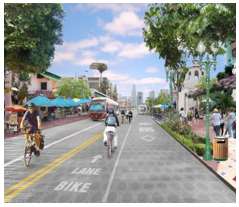 BIKING … THE VIEW FROM HERE--Good news for anyone who believes in the future of cities and humanity; bad news for the Neanderthals on the LA City Council who grunt nostalgically for the bad old days of traffic jams, road rage, sprawl, and blood on the streets. (And anyone who believes that road rage is a new phenomenon need only watch the 1950s Disney cartoon,
BIKING … THE VIEW FROM HERE--Good news for anyone who believes in the future of cities and humanity; bad news for the Neanderthals on the LA City Council who grunt nostalgically for the bad old days of traffic jams, road rage, sprawl, and blood on the streets. (And anyone who believes that road rage is a new phenomenon need only watch the 1950s Disney cartoon, 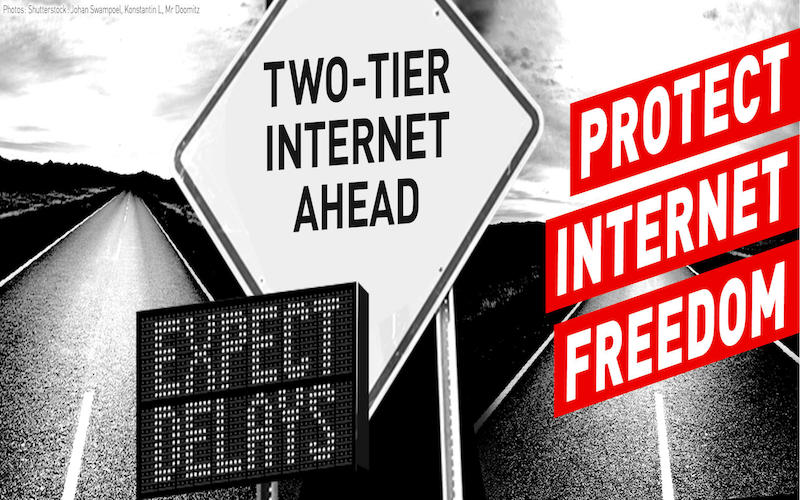
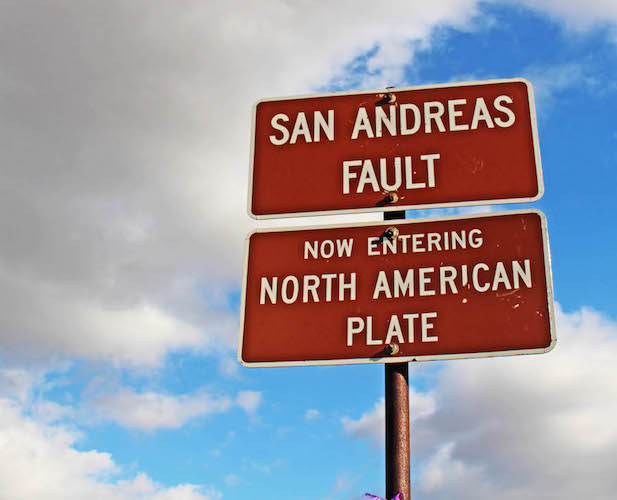
 But there are only so many police and firemen, not to mention trucks and ambulances. For the most of us, it will be the scenario I've characterized as You're On Your Own, aka YOYO, at least for a crucial 3 or 4 days. You won't have a lot of help from the uniformed agencies, because they will be tied up dealing with areas of dense population and mass casualties.
But there are only so many police and firemen, not to mention trucks and ambulances. For the most of us, it will be the scenario I've characterized as You're On Your Own, aka YOYO, at least for a crucial 3 or 4 days. You won't have a lot of help from the uniformed agencies, because they will be tied up dealing with areas of dense population and mass casualties. 
 One of the most moving scenes in the diary occurred when the students made a kind of feminist pilgrimage to pay respect to the novelist and social reformer Hannah More (photo), the high-minded rival of Jane Austen. As the author of numerous books—some of them huge bestsellers—she appeared to them the epitome of the England that Salih called the vilayat-i azadi, or “land of freedom.” The students praised her learning and library; she gave them signed copies of her books, which they promised to print when they returned home.
One of the most moving scenes in the diary occurred when the students made a kind of feminist pilgrimage to pay respect to the novelist and social reformer Hannah More (photo), the high-minded rival of Jane Austen. As the author of numerous books—some of them huge bestsellers—she appeared to them the epitome of the England that Salih called the vilayat-i azadi, or “land of freedom.” The students praised her learning and library; she gave them signed copies of her books, which they promised to print when they returned home.
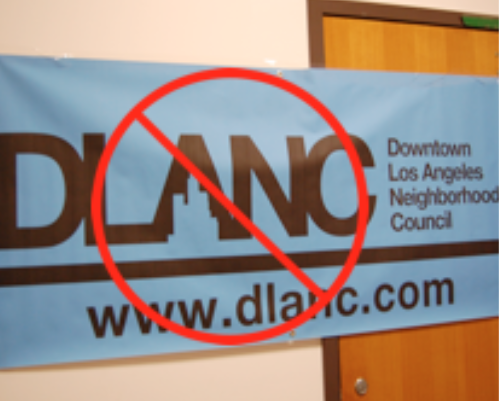
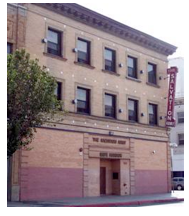 The timing for this sudden departure is even more interesting because there is a proposed development in Skid Row to convert buildings that were previously used by Salvation Army (photo) to provide housing and services to homeless and formerly homeless. The developer now wants to change it into an adaptive reuse project which plans to provide market-rate, micro-unit housing to students and workforce members -- in the heart of Skid Row!
The timing for this sudden departure is even more interesting because there is a proposed development in Skid Row to convert buildings that were previously used by Salvation Army (photo) to provide housing and services to homeless and formerly homeless. The developer now wants to change it into an adaptive reuse project which plans to provide market-rate, micro-unit housing to students and workforce members -- in the heart of Skid Row! 
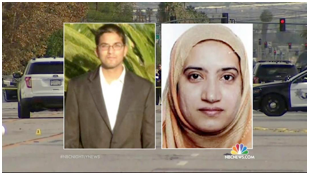 Serious gun control is needed now. Mere possession or sale of assault or any semi-automatic weapons should be declared grounds for possible criminal prosecution. A period of amnesty should be granted for all to turn in these weapons – even reimbursing the owners who can provide proof of purchase; otherwise, allow them to surrender the weapons anonymously.
Serious gun control is needed now. Mere possession or sale of assault or any semi-automatic weapons should be declared grounds for possible criminal prosecution. A period of amnesty should be granted for all to turn in these weapons – even reimbursing the owners who can provide proof of purchase; otherwise, allow them to surrender the weapons anonymously.  In the wake of the horrific attacks in Paris on Nov. 13, there has been a crushing backlash against refugees from the wars in Syria, Iraq and Afghanistan. A cartoon has been circulating on social media showing a Native American man greeting a Pilgrim, saying, “Sorry, but we’re not accepting refugees.”
In the wake of the horrific attacks in Paris on Nov. 13, there has been a crushing backlash against refugees from the wars in Syria, Iraq and Afghanistan. A cartoon has been circulating on social media showing a Native American man greeting a Pilgrim, saying, “Sorry, but we’re not accepting refugees.” 













